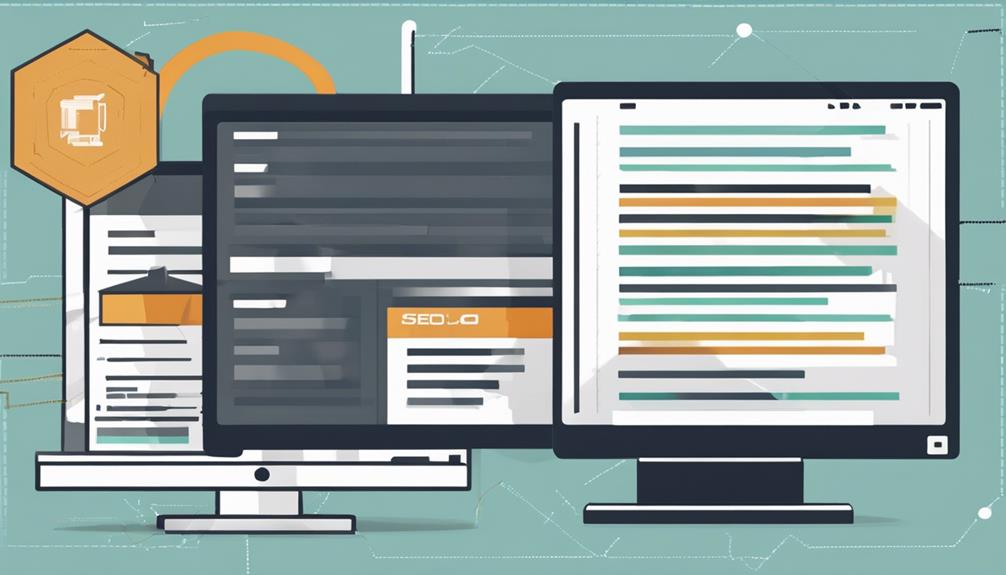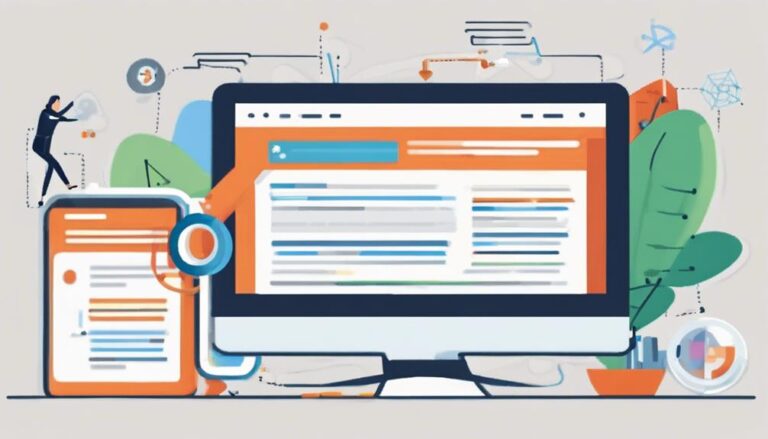
When it comes to optimizing your website for search engines in 2021, ensuring your URLs are clear and descriptive is crucial.
But that's just the tip of the iceberg.
By understanding how to effectively utilize meta tags, implementing a mobile-friendly design, and employing strategic internal linking, you can significantly boost your on-page SEO performance.
Stay tuned to discover how these key elements can transform your website's visibility and drive organic traffic, making your efforts truly worthwhile.
Key Takeaways
- Optimize meta tags, titles, and content with targeted keywords for improved search engine visibility.
- Structure on-page content effectively using meta tags, title tags, and heading tags to enhance SEO performance.
- Create keyword-rich and concise URLs to boost search engine rankings and click-through rates.
- Enhance website performance by optimizing code, compressing images, and implementing browser caching for better user experience.
Keyword Research Strategy
To optimize your on-page SEO effectively in 2021, implementing a comprehensive and data-driven keyword research strategy is paramount. Start by utilizing tools like SEMrush Keyword Magic Tool to delve into the world of keyword research. Focus on long-tail keywords that cater to specific search intent, allowing you to target niche audiences more effectively. Prioritize keywords with high search volume and low competition to increase your chances of ranking well in search engine results. Incorporate these chosen keywords strategically into your meta tags, titles, and on-page content to enhance your SEO efforts.
Additionally, conducting competitor analysis to understand their keyword strategies can provide valuable insights. By identifying gaps and opportunities in their approach, you can refine and improve your own keyword strategy. Remember, the key to successful on-page SEO lies in meticulous keyword research, understanding search intent, and staying ahead of the competition. By following these steps diligently, you can boost your website's visibility and organic traffic significantly.
Meta Tags Optimization
Optimizing meta tags is a critical element in your on-page SEO strategy, essential for providing concise and informative details about your webpage content. Title tags play a vital role in on-page SEO by ideally being 60-65 characters long, including primary keywords for relevance. This length ensures visibility in search results, contributing to improved search engine rankings.
Meta descriptions, limited to 160 characters, should be compelling and informative to enhance click-through rates from search engine users. Effective optimization of meta tags not only boosts search engine rankings but also enhances user experience by aligning webpage content with user search intent.
Heading Tags Importance
Heading tags are fundamental to structuring your content effectively and signaling its importance to search engines, playing a crucial role in enhancing both user experience and SEO performance. When it comes to on-page SEO, optimizing your heading tags is paramount. Here's why they're so crucial:
- Hierarchy: Properly structured heading tags, with the H1 tag at the top, help establish a clear hierarchy for your content, aiding search engines in understanding the importance and flow of information on your page.
- Keyword Optimization: The H1 tag holds significant weight in SEO; make sure it includes your primary keyword to boost your page's visibility and relevance to search engines.
- User Experience: Utilizing keyword-rich heading tags not only improves your SEO performance but also enhances user experience. Clear, descriptive headings make it easier for visitors to navigate your content, potentially increasing click-through rates.
URL Structure Best Practices
When structuring your website's URLs for optimal search engine performance, prioritizing concise and keyword-rich elements is vital. Keeping URLs concise and including primary keywords not only improves search engine visibility but also enhances SEO performance.
By removing unnecessary filler words and maintaining URLs under 60 characters, you can ensure optimal display in search results. It's crucial to make URLs search engine-friendly by using hyphens instead of underscores, as search engines prefer this format for readability.
A well-structured URL can positively impact click-through rates and overall SEO effectiveness. Remember, following URL best practices is a fundamental aspect of on-page SEO analysis. By implementing these strategies, you can create URLs that aren't only user-friendly but also optimized for search engines, ultimately boosting your website's visibility and performance.
Alt Text Optimization Techniques
When optimizing alt text for images on your website, it's essential to include descriptive keywords that accurately reflect the image content, improving its visibility in search results.
Utilizing relevant keywords in alt text not only enhances SEO but also boosts the likelihood of your images appearing in relevant search queries, driving organic traffic.
Image Alt Text
To enhance your on-page SEO strategy for 2021, mastering the optimization techniques for image alt text is crucial. When optimizing your image alt text, consider the following:
- Be Descriptive and Relevant: Ensure your alt text accurately describes the image content in a concise manner.
- Include Primary Keywords: Incorporating primary keywords in your alt text can boost image SEO and enhance overall page optimization efforts.
- Improve Accessibility and Rankings: Providing descriptive alt text not only helps visually impaired users understand the content but also assists search engines in interpreting the context of images, potentially leading to better rankings.
SEO Benefits
Alt text optimization techniques play a pivotal role in elevating your website's SEO performance. By enhancing accessibility, boosting keyword relevance, and providing crucial context to search engine crawlers. Incorporating relevant keywords into alt text improves image SEO and on-page optimization efforts. This optimization helps search engines better index your content, leading to higher rankings in image search results and increased organic traffic.
Proper alt text descriptions not only benefit your SEO but also enhance user experience by offering valuable information about the images. Focusing on alt text optimization is essential for maximizing accessibility, improving rankings, and driving organic traffic to your website.
Best Practices
In optimizing alt text for your images, it's essential to adhere to best practices that enhance both accessibility for users and search engine optimization effectiveness. When focusing on alt text optimization, consider the following key strategies:
- Use descriptive keywords: Ensure your alt text includes descriptive keywords that accurately depict the image to improve accessibility and SEO.
- Improve accessibility: Craft alt text that provides a clear and concise description of the image, enhancing accessibility for visually impaired users.
- Enhance SEO visibility: Incorporate primary keywords into your alt text to signal relevance to search engines, potentially boosting organic traffic and visibility as part of your on-page SEO strategy.
Page Load Speed Optimization
Maximizing page load speed is essential for optimizing your website's performance and user experience in today's digital landscape. Page load speed is a critical ranking factor that can significantly impact user behavior on your site. By optimizing your code through techniques such as minifying CSS and JS, you can reduce load times by up to 50%. Compressing images is another key aspect of load speed optimization, with Google suggesting images be under 100KB for optimal performance. Additionally, enabling file compression and browser caching can further enhance load speed by reducing server response times. Faster load speeds not only improve user experience but also lead to higher conversion rates and lower bounce rates, making it imperative for businesses to prioritize load speed optimization.
| Load Speed Optimization | Facts | Importance |
|---|---|---|
| Optimize Code | Reduce load times by up to 50% | Critical for performance |
| Compress Images | Improve load speed significantly | Enhances user experience |
| File Compression | Reduces server response times | Enhances site performance |
| Browser Caching | Enhances load speed | Improves user experience |
| User Experience | Faster sites lead to higher conversion rates and lower bounce rates | Vital for business success |
Mobile-Friendly Design Considerations
When optimizing your website for mobile-friendliness, it's crucial to prioritize responsive design to ensure seamless user experience across various devices. This approach not only enhances usability but also contributes to lower bounce rates and increased conversions.
Responsive Design Importance
Ensuring your website's design is responsive to mobile devices is a critical factor in optimizing SEO performance for 2021. With over 50% of web traffic originating from mobile devices, having a responsive design is imperative to cater to this significant portion of users. Google gives preference to mobile-friendly websites through mobile-first indexing, making responsive design essential for maintaining or improving search rankings.
Non-mobile-friendly sites risk being penalized by Google, leading to decreased visibility and traffic. Additionally, responsive design plays a vital role in enhancing user experience across different devices, ultimately boosting engagement metrics. Websites that are mobile-friendly tend to have higher conversion rates, underlining the importance of prioritizing responsive design for improved SEO analysis and overall performance.
User Experience Optimization
To optimize user experience on your website, prioritizing mobile-friendly design considerations is paramount in boosting SEO performance for 2021. With Google's Mobile-First Indexing emphasizing mobile content, your site's mobile optimization plays a crucial role in search rankings.
Ensure your website incorporates responsive design, fast load times, and easy navigation to cater to mobile users who represent over 50% of global website traffic. A mobile-friendly design not only aligns with SEO best practices but also enhances user experience, reducing bounce rates and increasing engagement.
Internal links and a mobile-responsive layout contribute to a seamless user journey, ultimately improving your site's mobile-friendliness and search engine visibility. Make mobile optimization a top priority for a competitive edge in the digital landscape.
Effective Internal Linking Strategies
Implementing a well-planned internal linking strategy is crucial for maximizing the SEO potential of your website. Strategic internal linking can significantly impact various aspects of your site's performance, from SEO to user experience. Here are three key strategies to optimize your internal linking:
- Distribute Link Equity: By strategically placing internal links throughout your content, you can distribute link equity evenly across your website, thereby boosting your SEO efforts.
- Enhance User Experience: Utilize relevant anchor text in your internal links to improve user experience and navigation, guiding visitors to relevant content and reducing bounce rates.
- Increase Page Authority: Implementing a thoughtful internal linking structure can increase page authority and positively impact your keyword rankings, helping search engines crawl and index your site more effectively.
User Experience Enhancement
Enhancing user experience on your website is a critical component of maximizing engagement and conversion rates. To boost conversion rates by up to 400%, prioritize user experience enhancement.
With 88% of online consumers unlikely to return after a negative experience, optimizing for mobile users is crucial. Mobile optimization is key as mobile users are 5 times more likely to abandon tasks on non-optimized sites.
Additionally, page load speed is paramount, with 47% of consumers expecting a load time of 2 seconds or less. Websites loading within this timeframe have a low 9% bounce rate compared to a 38% bounce rate at 5 seconds.
What Are Some Additional On-Page SEO Analysis Tips for 2021?
When it comes to boosting your website’s search engine ranking, onpage seo analysis tips are essential for 2021. Make sure to optimize page titles, meta descriptions, and headers for relevant keywords. Utilize structured data to help search engines better understand your content. And don’t forget to focus on improving page loading speed for better user experience.
Conclusion
In conclusion, implementing top on-page SEO analysis tips for 2021 is crucial for improving your website's visibility and search engine rankings.
While it may seem overwhelming at first, prioritizing technical elements and continuously monitoring results will lead to success.
You may be concerned about the time and effort required, but the long-term benefits of increased traffic and conversions make it well worth the investment.
Stay focused and watch your online presence flourish.
- Google Business Profile Optimization Tips - 15/09/2025
- 7 Proven Strategies to Attract More Local Customers - 09/09/2025
- What Is Local SEO and Why Does It Matter? - 08/09/2025


